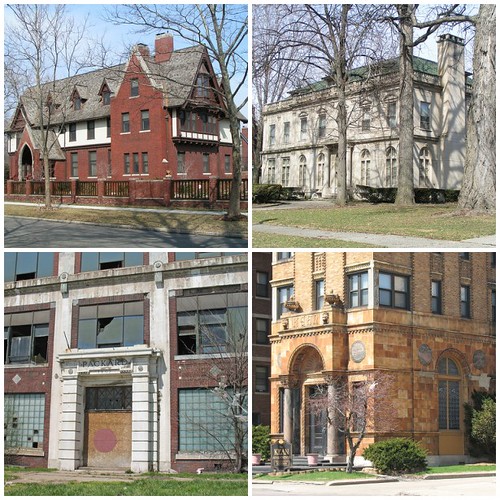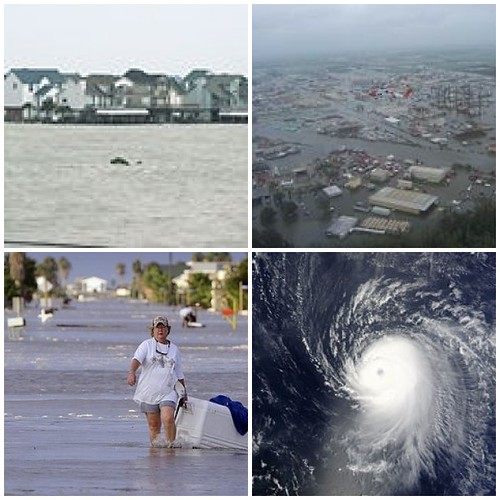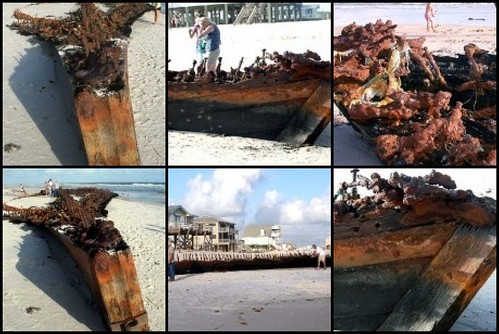Hurricane Ike was the ninth named storm, and fifth hurricane of the 2008 Atlantic hurricane season.[1] It was a Cape Verde-type hurricane, as it started as a tropical disturbance off the coast of Africa near the end of August, then tracked south of Cape Verde and slowly developed. On September 1, it became a tropical storm west of the Cape Verde islands.[2][3]
By the early morning hours of September 4, Ike was a Category 4 hurricane, hitting its peak with 145 mph (233 km/h) winds and a pressure of 935 mbar (27.61 inHg).[4] That made it the most intense storm so far in the 2008 Atlantic hurricane season. At one point the diameter of Ike's tropical storm and hurricane force winds were 450 and 190 miles (720 and 305 km), respectively. Ike has been blamed for 145 deaths, primarily in Haiti, which was already trying to recover after the impact of three prior 2008 systems, Fay, Gustav, and Hanna, and in the United States, with many of the deaths taking place well inland. Damages from Ike in US coastal areas are estimated at $27 billion (2008 USD), with additional damage of up to $4 billion in Cuba.[5] If the estimates are accurate, Ike will be the third or fourth costliest Atlantic hurricane and third costliest U.S. hurricane of all time
Formed September 1, 2008
Dissipated September 14, 2008
Highest
winds 145 mph (230 km/h) (1-minute sustained)
Lowest pressure 935 mbar (hPa; 27.62 inHg)
Fatalities 145 direct, 37 indirect, 400 missing
Damage $29.5 billion (2008 USD)
(estimated)
Areas
affected Turks and Caicos, Bahamas, Haiti, Dominican Republic, Cuba, Florida Keys, Mississippi, Louisiana, Texas, Mississippi Valley, Ohio Valley
Part of the
2008 Atlantic hurricane season
“A lot of people felt it was a false alarm,” he said. “I think they're realizing this is not a false alarm.”
While more than 2 million people evacuated ahead of Ike, tens of thousands more ignored evacuation orders and swamped rescue crews Saturday with emergency calls from the flooded lowlands of East Texas and western Louisiana.
“Of course it's frustrating. There was a mandatory evacuation, and people didn't leave,” said Steve LeBlanc, Galveston's city manager. “They had enough time to get out. It's just unfortunate that they decided to stay.”
 I heard on the News between my daily activities,and kids cartoons that a hurricane was approaching the United States in a few days!...went about my daily routines until Shadd and a couple of friends as well as Bussiness Partners (David and Ray)were already in flight to Detroit Michigan for a Convention they were to attend.Friday night there flight took off late and connecting flight they had missed leaving them to wait at the Chicago Ohare Airport for 10 hours until they boarded the next plane.Mind you by this time it's Saturday morning and the Hurricane is pounding Texas,and on its way to Chicago Ohare which by mid-morning was 6-10 inches under water with no one entering or leaving.Still no call from Shadd only a text saying they had been delayed.At this time I'm a complete mess wondering were they are? Took the kids to the beach and it was then I had received a call from Shadd with the whole story and that they were at the convention but arrived late.They were enjoying there time,but were exhausted,and the weather was "crappy" lot's of rain.The buildings were amazing there very Gouthic like and he'd wished I could've gone to take photos,and that he missed all of us.Sunday afternoon was another day of meetings and here I am at home watching the news again (I was glued to that T.V).
I heard on the News between my daily activities,and kids cartoons that a hurricane was approaching the United States in a few days!...went about my daily routines until Shadd and a couple of friends as well as Bussiness Partners (David and Ray)were already in flight to Detroit Michigan for a Convention they were to attend.Friday night there flight took off late and connecting flight they had missed leaving them to wait at the Chicago Ohare Airport for 10 hours until they boarded the next plane.Mind you by this time it's Saturday morning and the Hurricane is pounding Texas,and on its way to Chicago Ohare which by mid-morning was 6-10 inches under water with no one entering or leaving.Still no call from Shadd only a text saying they had been delayed.At this time I'm a complete mess wondering were they are? Took the kids to the beach and it was then I had received a call from Shadd with the whole story and that they were at the convention but arrived late.They were enjoying there time,but were exhausted,and the weather was "crappy" lot's of rain.The buildings were amazing there very Gouthic like and he'd wished I could've gone to take photos,and that he missed all of us.Sunday afternoon was another day of meetings and here I am at home watching the news again (I was glued to that T.V). There flight is around 11:00 am (2:00pm there time)and Hurricane Ike which has now been catagorized as a Tropical Storm is now headed directley in there path to go through Detroit and be in New York or Florida by Evening.Again no phone calls until 8:00pm(I finally get one)they're in Santa Ana and driving home!Yeahhhhhh(all this time Shadd had been texting but none of the texted had gotten throu)This is why we have cell phones in case of an EMERGENCY!! So glad they're home safe and sound....you don't realize sometimes how much you love someone until something this "HUGE" comes along and could take them in an instant....I love you so much my husband....XoXo's,your Wife
There flight is around 11:00 am (2:00pm there time)and Hurricane Ike which has now been catagorized as a Tropical Storm is now headed directley in there path to go through Detroit and be in New York or Florida by Evening.Again no phone calls until 8:00pm(I finally get one)they're in Santa Ana and driving home!Yeahhhhhh(all this time Shadd had been texting but none of the texted had gotten throu)This is why we have cell phones in case of an EMERGENCY!! So glad they're home safe and sound....you don't realize sometimes how much you love someone until something this "HUGE" comes along and could take them in an instant....I love you so much my husband....XoXo's,your Wife











































